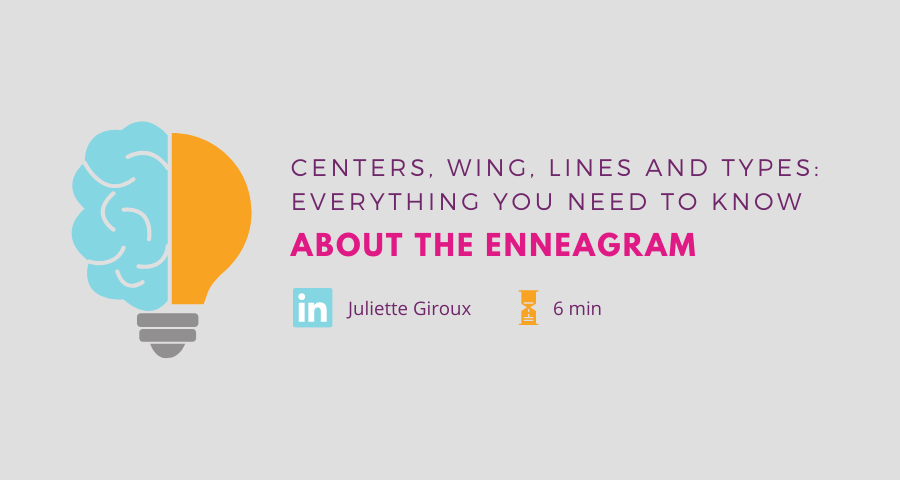Here we are: my 9th blog post already. Next week will be the last, and you better stick with me until then, because it will be a reading recommendations video. Many of you have asked me which books I’d recommend you, so it seemed obvious I’d leave you with a bunch more things to read to continue your self-knowledge journey.
Anyways, this week we’re not here to talk about books, but about our very last personality types theory. We’ve already discussed the MBTI and astrology but today it’s time to tackle something a bit different: The Enneagram types. You might already be familiar with the model, as it is very popular. If you aren’t or if you want some further insights, keep reading.
THE BASIC CONCEPT OF THE ENNEAGRAM
It’s pretty unclear where the Enneagram comes from. It seems to be very ancient and connected to different spiritual, mathematical and philosophical traditions, though its modern version was developed by Oscar Ichazo in the 1960s (Source: integrative9.com).
In a nutshell, the Enneagram is a nine-sided figure, that looks as followed:

It usually seems a bit scary the first time you see it, but if you’re being given a proper explanation, it’s actually pretty easy to understand.
As you can see, the Enneagram is composed of nine types that all have an individual name. Their number doesn’t have any value and only serves to order them. What you can also notice, is how the types are connected. This part is very important and is unique to the Enneagram model. We’ll come back to that.
Usually, everyone is a bit of all of the nine types but has one that particularly stands out. It is called the “basic personality type”. This type is dominating your personality and does so since your childhood. Note that it is not possible to switch basic types, you will keep the same one your entire life (Source: enneagraminstitute.com). You must wonder: “how can I determine my basic type?”. Well as for all personality types models, you should simply take a test. Official ones must be paid for, but you can also find many online, that will give you a pretty solid idea. And you can already start identifying it by reading the description of each type later on in this article.
I will now introduce you to the other significant aspects of the model.
THE THREE CENTERS
What is important to know about the Enneagram, is that it’s a 3 x 3 arrangement of the nine types in what is referred to as the “three centers”. There are three types in each center, and they are split as followed:

Each center is composed of types that share similar strengths and weaknesses.
THE WING
If you are to take an Enneagram personality test, you must know about the “wing”, as it will most likely appear in your results. Your wing is one of the adjacent types to your basic type (e.g. for a basic type 3 it can be a type 2 or 4). The Enneagram Institute explains the wing as followed:
“Your basic type dominates your overall personality, while the wing complements it and adds important, sometimes contradictory, elements to your total personality. Your wing is the “second side” of your personality, and it must be taken into consideration to better understand yourself or someone else.” (Source: enneagraminstitute.com)
THE LINES
Let’s go back to the links between the types. Each basic type is connected to two lines that go in opposite directions: one is pointing at the type and one is pointing away.
The line that is pointing at the type is called the “line of release”. Our personality follows this line when it’s feeling safe and at peace. It means that when we are in a good place mentally and physically, we are most likely to be sharing the positive characteristics of the type from which the line comes from. For example, if you take a look back at our visual from the beginning of the article, you can see that when a basic type 4 is feeling good, it will more likely take the positive characteristics of a type 1.
On the contrary, the line that is pointing away from our basic type indicates which type we take the negative characteristics of when we are in a bad place, feeling stressed or hurt. It is our “line of stretch”. So, in the case of a basic type 4, it’s likely that they take the negative characteristics of a type 2 when they are in a pressuring situation.
THE NINE TYPES
I’ll keep it short for today. It you want further insights, you can go on the Enneagram Institute website or any other reliable source. Here are the basic descriptions of each type, according to the Institute:
- Type 1: The Reformer
The Rational, Idealistic Type: Principled, Purposeful, Self-Controlled, and Perfectionistic
- Type 2: The Helper
The Caring, Interpersonal Type: Demonstrative, Generous, People-Pleasing, and Possessive
- Type 3: The Achiever
The Success-Oriented, Pragmatic Type: Adaptive, Excelling, Driven, and Image-Conscious
- Type 4: The Individualist
The Sensitive, Withdrawn Type: Expressive, Dramatic, Self-Absorbed, and Temperamental
- Type 5: The Investigator
The Intense, Cerebral Type: Perceptive, Innovative, Secretive, and Isolated
- Type 6: The Loyalist
The Committed, Security-Oriented Type: Engaging, Responsible, Anxious, and Suspicious
- Type 7: The Enthusiast
The Busy, Fun-Loving Type: Spontaneous, Versatile, Distractible, and Scattered
- Type 8: The Challenger
The Powerful, Dominating Type: Self-Confident, Decisive, Willful, and Confrontational
- Type 9: The Peacemaker
The Easygoing, Self-Effacing Type: Receptive, Reassuring, Agreeable, and Complacent
HOW TO USE THE ENNEAGRAM?
If you still don’t know why knowing more about your and others’ personalities is useful, I encourage you to read my past articles, especially the first one, that gives you an introduction to the power of self-knowledge an how it can improve your life, mental health and relationships.
You might wonder why I presented you so many personality types models in the past few weeks. While I don’t think it’s possible to refer to several at once, I think it’s crucial to know about as many as possible. Why? Well first of all, because that’s what’s going to help you find the one that resonates the most within you. If you only know and use one, it might not be the most fitted, which would prevent you from making the most out of it. On the contrary, if you test several different ones, you will be able to choose the one you prefer. I hope by presenting you three models, I was able to make you aware of their differences, in order for you to pick a favorite. It’s also possible to use more than one at a time. I personally refer to two in general, which helps me having contrast and different perspectives on people, so I don’t put them in one box without apprehending all the nuances of their personalities. Finally, knowing different models can also be helpful in external situations, like finding a job or discussing with friends. They might want to talk/use a different tool than the one you prefer, but you will still be able to take part and know what it is about. Knowledge is power!
I hope this article helped you understanding the Enneagram model and gave you a new self-knowledge tool to add to your toolbox. It is pretty different from the MBTI, as it explains what we think, while the MBTI focuses on how we think. You might prefer one or the other and it’s OK. Anyhow, you are now able to start observing your and others’ behaviors, identifying patterns that you can link to particular types, and consequently adjusting the way you act around these people.
Now please tell me in the comments below: have you ever taken an Enneagram test? If so, what is your basic type? Also, which model between the MBTI, astrology and the Enneagram do you prefer and why?
Don’t forget to follow me on LinkedIn to stay informed of the publication of my next and last post on Tuesday.
And until then, take care!




I have not (yet) taken the Enneagram test but have heard from people who have read a book about it that it can also make you feel pretty uncomfortable as it also challenges your view of yourself – definitely an interesting topic. I think I will take a test to find out about my wings, lines and centers. 🙂 Looking forward to your book recommendations next week 🙂
Hello Katharina,
Thank you for your comment. You definitely should take a test to figure it out. I don’t know if it makes me feel uncomfortable but types definitely all come with their negative aspects and so you have to accept it too. I hope you’ll like next week’s video!
See you then,
Hi Juliette, very interesting once again! I’ve heard about the enneagram before, but didn’t know all the details. What is your type?
I can’t wait for the reading recommendations video next week!
Marek
Hello Marek,
Thank you for your comment. I’m glad you can now understand the Enneagram model better. I am a type 4 with a wing 3. What about you?
I hope you will like next week’s video.
See you then,
Thank you for sharing that, I did not know anything about the Enneagram. I have learnt a lot and it gave me the interest to read more about it. Thank you!
Hello Lucie,
Thank you so much for your positive feedback. I’m glad the topic interested you!
See you soon hopefully,
I’ve done the enneagram test before, I got a type 3 with 2 wing I feel it’s awesome to talk between friends and find each others type.
Hello Izak,
Thank you for your feedback. I agree, it’s pretty cool to have this knowledge in common and be able to discuss it! Now hopefully you can even add insights about your center or your lines to the discussion!
See you soon,
Thank you for helping to spread the word about Enneagram essentials. We can really benefit from using Enneagram as a tool to become a better person!